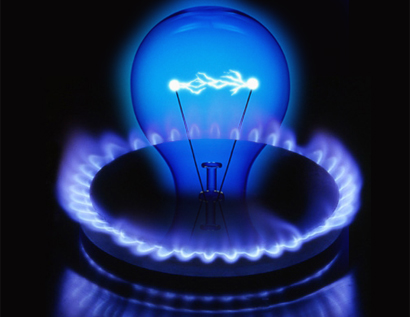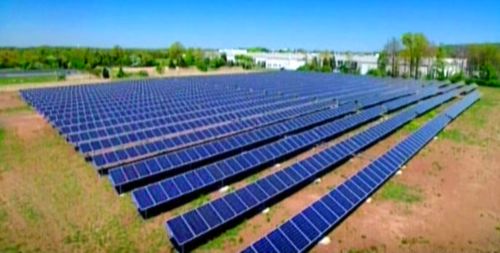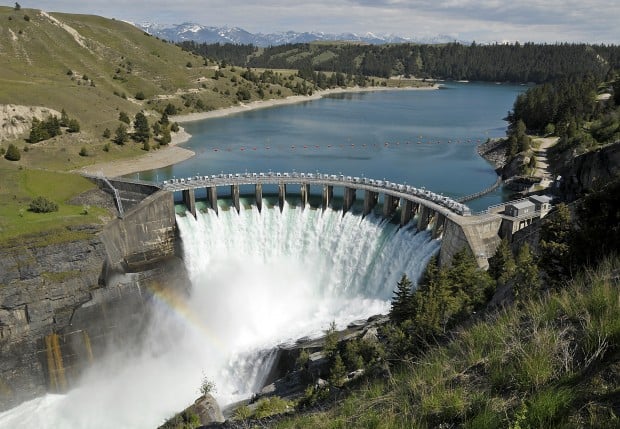Energy Sources
Non-Renewable:
A non-renewable resource is an economic value that cannot be replaced by natural means on a level equal to it's consumption.
Coal:
written by Brianna Ramos
Coal is a nonrenewable source because coal comes from fossil fuels that take million years to form. Coal is made up of the remains of ancient trees and plants that grew in swampy jungles hundreds of years ago. All energy in coal originally came from the sun, through photosynthesis. Coal mining is a very dangerous activity because you can die by gas poisoning and gas explosions. Coal contains sulfur, including dangerous metals such as mercury, lead, and arsenic, that escape into the air when coal is burned. Burning coal also produces particulars that increase air pollution and health dangers. Burning coal emits the carbon dioxide in the atmosphere. Agriculture or hunting and gathering food is interrupted. The United States, about 67% of the electricity generated was from fossil fuels, coal being 33% of the electricity generated. The Benxihu colliery disaster in China cost 1,549 lives and is believed to be the worst coal mining disaster ever. It occurred on April 26, 1942 in the Honkeiko coal mine. Yes, coal is a viable energy source because it is the cheapest source of energy. Coal provides many jobs for people.
https://www.eia.gov/tools/faqs/faq.cfm?id=427&t=3
 http://www.durhamintime.org.uk/durham_miner/coal_mining_timeline.pdf
http://www.durhamintime.org.uk/durham_miner/coal_mining_timeline.pdf
Oil: written by Bryant Pedreros
Oil supplies around 34% of the worlds energy needs. It is often referred to as fossil fuel because the oil is extracted from built up organic material and fossil material remains that over time, breaks down into hydrocarbons. Oil is mostly used as transportation fuel but it is also found in many other products like fertilizers, makeup, paints and fabrics. Our lives would be different without oil. United states only uses over 19.5 million barrels of crude oil each day.
By 1859, people realized the value of oil and the drilling began.The Pennsylvania Rock Oil Company was the first the begin the process of drilling oil from the ground, rather than collecting what speed to the top. However, it wasn't until 2870 that the oil industry really boomed. Even today oil continues to be a huge commodity and is still being drilled for in many part of the world. Crude oil is found deep under the earths surface and has been there for millions of years. It is actually formed by fossilized plants and animal mattr. Oil is also found deep in the oceans floor, but is more difficult to get at. There is also a form of oil found in plants. Vegetable oil is extracted from sunflowers, corn, coconuts, peanuts, and palm oil too. Oil is used for medicine, paint, cooking, pens, clothing, plastic bottles, and lubricants too.
Oil is so valuable it is called, " Texas Tea" or Black Gold". Crude oil has been used for over 5,000 years. Also oil is measured in barrels, one barrel is equal to 42 gallons or 159 liters. Oil is considered as " Non Renewable" that means it could run out. I also found that Saudi Arabia is the biggest supplier of oil in the world. Oil is a hydrocarbon derived from material typically from seas and lakes buried under great pressure and heat. It has three main properties which are density, viscosity, and solubility .


Natural Gas:
written by Josh Huayamave
Natural gases are not a renewable resource. They come from the buried remains of plants and animals that lived millions of years ago, so in order to have more natural gas to be available we’d have to wait a few million years for it to be available. Just like any other non renewable resource, natural gases release pollution into the air we breathe.
Natural gases provide a huge amount of energy for the united states, a huge fraction of the united states rely on natural gases for electricity. This year alone, natural gases have provided electricity for 30% of the united states. Compared to coal which provides electricity for 34% of the nation and oil that only covers 1% of the nation’s electricity, natural gas is second in line for the most used source for electricity. Natural gas is the predominant source of power in 15 states including all of the gulf of Mexico states, Virginia, Georgia, New York, Massachusetts, Nevada, and California. Basically almost all the east coast of the united states and the state of California use natural gases for electricity. From what i’ve found on the web, there hasn’t been any disasters or accidents affiliated with natural gas plants.
As of January 1, 2013 there were about 2,276 trillion cubic feet of technically recoverable natural gases in the united states. By technically recoverable i mean natural gases that are available from the ground at the moment. When companies are digging for natural gas and find it they use pipes that lead to gas tanks to retrieve it and from there the gas tanks can be shipped to natural gas plants and even to other countries. At the rate of the U.S. consumption of natural gases, there is enough in the U.S. to last at an estimate of 84 years. But the actual amount of years these resources will last will depend on the amount consumed each year, natural gas imports and exports, and additions to natural gas reserves. I think at the rate the U.S. is at right now, we are going to continue to use more natural gases for electricity and by the end of the year, natural gases are going to be supplying more electricity for people than coal and oil do.
 Sources:
Sources:
Nuclear:
written by Eddie Sanchez and Nara Chaim Maramot
Nuclear energy is a non-renewable energy source that many countries use to power their cities. Nuclear energy is non-renewable source because it needs uranium and uranium is found by mining. Kazakhstan, Australia, and Canada are countries that use the most uranium. Nuclear energy has little impact to the environment because it does not produce air pollutants or greenhouse gases. Nuclear energy power plants does not need big space.
Nuclear energy produces about 20% of the United States power. The United States has 61 nuclear power plants in 30 states. Nuclear energy is very dangerous and since there are hundreds of power plants around the world there occasionally are some disasters that have happened and are probably going to happen again. One of the most famous disasters was in Russia 1986 when a nuclear power plant in Chernobyl exploded and released deadly amounts of radioactive particles in the atmosphere. Thousands of people were forced to flee their homes and 31 people died from the incident but long term effects from families and children who were exposed to the radiation soon developed cancer. Even though nuclear energy powers a good amount of the world’s energy I believe it will stop not soon but eventually since uranium is nonrenewable. Also nuclear energy has the potential for very dangerous accidents so i think there will come a time that nuclear energy would be considered a bad idea.
The five renewable energy that is used a lot is biomass, wind, solar, hydro, and geothermal. Nuclear energy in the other hand is non-renewable. Nuclear energy is energy that comes from a nucleus. There are two ways for energy to be released from an atom, nuclear fusion, or nuclear fission. Nuclear fusion is how the atoms combine to a larger atom. Nuclear fission is when the atoms split into smaller atoms releasing energy. Nuclear power plants uses nuclear fission to create electricity, but for it to work they use uranium. It is considered as nonrenewable because the energy that a nuclear power produces cannot be constantly replaced. Uranium can’t be made unlike wind energy and solar energy.
The fuel that makes nuclear energy is uranium. Apparently uranium is made from supernovas 6.6 million years ago. It is mined from the ground using three methods, open-pit, underground, and in-situ leach (ISL.) Open pit mining is also known as strip mining, is the removal of superficial soil and uneconomic rock to get the ore below. This type of mining is only used when the uranium is close to the surface (less than 400 ft.) Underground mining is used when the uranium is too deep for open-pit mining. The ore is drilled and then blasted to create debris, which will be transported to a mill. The ISL is a preferred method, which is when they leave the ore in the ground recovering the minerals in it by dissolving them then pumping up the pregnant solution to the ground where they recover the minerals.
Uranium may be radioactive but it’s not rare. Uranium can be found in small amounts in rocks, water, and soil. The uranium concentration in the air is very low. In water, most of the uranium is dissolved comes from the rocks, and soil that the water runs over. Only a very small amount of uranium settles in the water from the air, uranium in drinking water is generally low. The uranium found in soils are low too, us human add more from industrial activities. Erosions of tailing from mines and mills may cause more uranium to be released in the environment.
The U.S is the largest producer of nuclear energy, accounting of more than 30% of the world’s nuclear use. The country’s 100 nuclear reactors, produced over 798 billion kWh in 2015. About 20% of the U.S power supply comes from nuclear energy. The biggest producer of energy is petroleum, nuclear energy is 4th biggest producer. The scalability of nuclear energy is that it decreases the world’s need of burning fossil fuels. Fossil fuels are burned more than produced. Also they can lower the emission of carbon dioxide and other greenhouse gases. Nuclear energy can be used for a whole cities’ electricity. It is better than having your nuclear plant for individual uses, because to create nuclear you need uranium, and uranium isn’t renewable you need to mine for it and not a lot of people has the “talents” to mine uranium without being exposed to radioactive gases.
Nuclear energy is used worldwide even though it’s helpful, there is still accidents. Fukushima, Japan, March 2011, an earthquake and tsunami hit the nuclear power plants on the northeastern coast of japan. The earthquake cut out the external powers to the reactor, while the tsunami that reached double the size of the tsunami the power plant was to withstand disable the backup diesel. Another disaster occurred in Chernobyl, Ukraine (former Soviet Union), April 26, 1986. When a power surge happened while testing the reactor system, it caused the power plant to explode. Nuclear energy is just getting popular to be used for electricity. The nuclear energy is increasing steadily worldwide. This energy is the most environmental friendly of producing energy on a large scale and electricity demands are increasing. We will be needing nuclear energy because the this energy doesn’t emit greenhouse gases and it will be a nice change for our environment.

Sources:
- Wikipedia - Chernobyl
- BBC News
- Energy Matters - Nuclear Energy
- Duke Energy - Nuclear Power
- NEI.org
- Uranium Mining
Renewable:
written by Jose Ortega
Solar:
written by Jose Ortega
Solar energy is a renewable source because it is sustainable and its inexhaustible. Solar power is also a non-polluting source of energy it does not emit any greenhouse gasses when creating electricity. Solar energy is collected by photovoltaic panels, the panel coverts the sun’s rays into electricity. There are no enrivonmental effects when solar energy is being produced or when using solar energy.

Solar power is the most reliable form of renewable energy available, and it can be used in several forms to help power homes or businesses.0.6% is the amount of the U.S power supply that comes from solar energy. My energy source can provide electricity for whole cities and countries because to power up my energy source you need the sun’s rays so as long as the sun is out and the photovoltaic panels are converting the sun’s rays it can power a plethora amount of things.
There have been no disasters associated with solar power, but there has been a couple of accidents,people have died when trying to install solar panels on roofs because they fall but other than that there has been no disasters just accidents.I feel like solar power will be a big part in the future.Solar panels are going to be everywhere in the near future the use of solar panels will continue to grow and more and more people will start using these solar panels to power up their homes or their businesses. More people on the west of the United States use the solar panels than people on the east side.These photovoltaic panels are mainly used for the bureau of land management and for the national park service.
There are several pros and cons on using solar power as our energy.First of all solar power needs exotic minerals, it's very expensive, and it requires space.But there are also many good pros on using solar power, this source is abundant, it is renewable, it is sustainable, it is environmentally friendly, it reduces electricity costs, it is silent and has financial support from the government or state. There is still a plethora amount of pros on using solar power as our energy.Also there is not that many cons on using solar power as our energy, if anything it would be very good if we use photovoltaic panels to produce energy.
Wind:
A lot of the electricity we use today is produced by the wind’s energy source.Wind is a renewable energy source. The winds energy can be used to power a wind turbine to generate electricity. Wind is an renewable energy source because wind comes from the changes in temperature and pressure which comes from the sun. The fuel for my energy source is collected by wind turbines which captures the wind and creates energy. There are no environmental effects from collecting or using the wind’s energy. Collecting and using the wind’s energy doesn’t affect the environment because all the energy from the wind is just being used to power wind turbines so that it can make electricity.
About 4% of the electricity generated is produced by wind energy. It is estimated that 20% of electricity in the U.S could be provided from wind energy source. My energy source scales well. It produces electricity not only for one individual, but for big cities and countries. By wind being a renewable source of energy, more wind turbines can produce more electricity for cities and countries. There have been many disasters associated with wind. Sometimes wind can be too strong and blow things away or knock things down. Many trees that have fallen and houses have been torn down because of the speed of the speed and power of wind.
The use of wind energy is very useful because people can use it without harming the Earth. I think the use of wind will increase in the future because people use a lot of electricity. In the future I think there will be more wind turbines and generators. The use of electricity in the Earth is caused mainly by wind. People use electricity to charge their things or plug in important things. If people use a lot of electricity there will be an increase in wind energy being used. Hopefully in the future, we will use more of these natural resources that don’t affect the Earth.

Hydroelectric:
written by Felipe Ogando
Hydropower is considered a renewable energy source because it does not consume any water, only using kinetic or potential energy from the water to generate electricity.
Hydropower, also known as hydro-electric power, is generated by hydro-electric dams place on many of the world’s major river.
Entire ecosystems could be damaged or at the very least effected by the establishment of this station using shouldn’t have any negative effects.
There are 1,436 hydroelectric plants in the U.S. They have generated 7 percent of the nation’s electricity this year. Washington, Oregon and Idaho lead the nation in power from hydroelectric plants. It’s a feast-or-famine source, providing 48 percent or more of the power in five states, but less than 10 percent of the electricity in 40 states. Government-run plants generate most of the power.
It is best suited for use on a large scale such as cities. However this method is only applicable to areas close to a sizable body water. It is not a method that can be implemented for more than a handful of areas. However the long term benefits for out way only any detriments.
Last year on august, a major failure occurred at sayano-shushenskaya hydroelectric dam in Russia. 75 people were killed, many were injured and 40 tons of oil were spilled in the yenisei river. With nearly 100 gigawatts of installed electric dam in the united states.
There will also be great leaps ahead for hydropower technology throughout the world. It is essential that society focuses to capitalize on the project at hand, ensuring that the most energy is produced while maintaining the nature ecosystems in surrounding regions.

https://www.washingtonpost.com/graphics/national/power-plants/
Geothermal:
Geothermal energy is heat from the Earth.Resources of Geothermal energy are hot water or hot rocks that are found beneath Earth's surface. Magma is another resource of Geothermal energy. The heat from the Earth is clean and sustainable. Geothermal heat pumps are used to heat or cool buildings. In the winter the heat pumps take th heat from the heat exchanger and pumps it into the indoor air delivery system. In the summer it is reversed and some of the heat is used for hot water. Many other technologies are being used to take advantage of geothermal energy.
Video on Geothermal Energy


Biomass:
written by Bryant pedreros
we have used biomass energy, or bio-energy the energy from plants and plants derived materials since people began burning wood to cook food and keep warm. Wood is still the largest biomass energy resources today, but other sources of biomass can also be used. Biomass can be used for fuels, production, and products that would otherwise be made from fuels. In such scenarios, biomass can provide an array of benefits.
The use of biomass energy has the potential to great reduce greenhouse gas emissions. Burning biomass release about the same amount of carbon dioxide as burning fossil fuels. However, fossil fuel release carbon dioxide captured by photosynthesis millions of years ago, an essentially "new" greenhouse gas. Biomass on the other hand, release carbon dioxide that is largely balanced by the carbon dioxide captured in its own growth. They can also use to reduce dependence on foreign oil because bio-fuels are the only renewable liquid transportation fuels available. Biomass energy supports U.S. agriculture and forests product industries. The main biomass feed stocks for power are paper mill residue, and lumber mill scrap.

